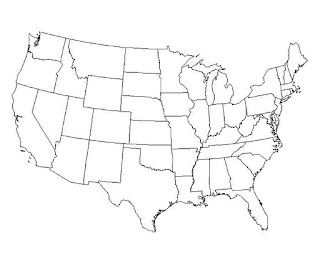 |
| Map of Red Storm Rising - Thin black lines indicates the various spaces |
Irregular Board
The following board comes from Red Storm Rising(RSR). The spaces are all polygons, mostly four sided, but put together like a mosaic. This type of board can require some time to decipher. Unlike hexagonal grids, where distance become easy to determine by simply counting from one hex to another, irregularly shaped boards do not always have a "clear shortest path" from one location to another. Adding in terrain effects (Rivers in RSR are more difficult to cross), and the calculations become more challenging.
The first question which comes to mind is "Who would come up with such a crazy map scheme". Probably the same group which tried to break states up by natural border lines, waterways, and political boundaries. An example of such a map is provided below:
 |
| Look familiar? |
The "Surface Area' of any given location is equal to the number of adjacent spaces. Color coding our Map of the United States, we get the following:
 |
| Individual Surface Areas of the States |
Maine, the state in the uppermost right, is the only state adjacent to a single other state. This means any attacks must come from New Hampshire. Compare this to Texas, the large state in the south, which may be attacked by any of its four neighbors: Lousiana, Arkansas, Oklahoma, and New Mexico. As expected, the states at the edge of the map have fewer neighbors than in the middle. Still, one state, Kansas, is dead center in the map but only has four neighbors.
Objective of Surface Area Games
Normally, in games with irregular maps, players try to create 'fronts'. A front consists of a group of units strung out along a contiguous line which faces the enemy. Since most games limit the number of units a player receives each turn, it is best if the player's front is smaller than their opponents.
This becomes basic mathematics and a war of attrition. If players received 12 units a turn, the player who occupies 4 locations will have 3 units added to each territory. If their opponent occupies 6 locations, then the opponent will have only 2 units per territory. Furthermore, the player has the option of attacking any 6 of their opponent's locations.
 |
| Kansas: Breadbasket, Corn fields, Stronghold Missouri: watch your back, front, top, bottom... |
Some games permit units from surrounding territories to combine their units in attacks. Even with this rule, Kansas stands out as a 'stronghold' in the center of the map. At most, 4 states could attack Kansas.
Compared to the state to its left, Missouri, where 8 states could combine efforts. In this case, the smaller surface area again provides advantages in defense.
Oddities like the "Stronghold of Kansas" exist in many such games. Identifying these oddball locations can create situations where players' "run to Kansas" just to force their opponents to thin their lines. In the Kansas situation, it is odd because it rests in the middle of the board. Thus, it differs from "Fortress Australia" from Risk.
 |
| Siam: Gateway to Fortress Australia |
Fortress Australia
"Fortress Australia" is another common configuration found in games with irregular boards. Made famous by Risk, the Fortress Australia configuration is more easily identifiable than "Stronghold Kansas". The primary feature is a section of the map with an obvious choke point.
In the game of Risk, the continent of Australia can only be attacked through Siam. Furthermore, if a player controls all of Australia's territories, the player gains bonus armies. While the bonus armies are few compared to North America, Europe, Africa or Asia, Australia has an advantage in that it is easy to defend. Furthermore, Australia is isolated next to the largest bonus continent: Asia. Defending Australia consists of Occupying Siam and building a massive force. While holding Siam, Australia provides 2 bonus armies and denies a player Asia's benefit of 7 armies.
The "Fortress Australia" is usually fairly obvious and the strategy around it is fairly simple. Railroad Tycoon has a similar "Fortress Australia" in the Northeastern States, where there is a greater concentration of cities with relatively easy terrain. If left alone, a single player can quickly dominate the game.
Next Article
The next article will discuss more about Surface Area as it applies to the players positioning. We will cover Tips for Attacking and Defending, setup the ground rules for a sample game, and discuss how irregularly shaped boards need to affect the overall strategy.
No comments:
Post a Comment